2009 PORSCHE PANAMERA trailer
[x] Cancel search: trailerPage 238 of 343

236
Storage, Luggage Compartment and Roof Transport System
Loading InformationDefinitionsThe rear-axle load is the vehicle weight on the
rear axle plus the weight of the transported load.
The Curb weight - actual weight of your vehicle -
vehicle weight including standard and optional
equipment, fluids, and emergency tools. This
weight does not include passengers and cargo.
The Gross Vehicle Weight is the sum of the curb
weight and the weight of passengers and cargo
combined.
The Gross Vehicle Weight Rating is the
maximum total weight of vehicle, passengers,
luggage, hitch, trailer tongue load and optional
equipment.
The Gross Axle Weight Rating is the maximum
load limit for the front or the rear axle. This
information is located on the safety comliance
sticker located in the dr iver’s side door jamb.
For determining the compat ibility of the tire and
vehicle load capabilities:
f Please see the chapter “TIRES AND WHEELS”
on page 280. The load capacity coefficient (e.g. “106”) is a
minimum requirement. For more information:
f
Please see the chapter “INSCRIPTION ON
RADIAL TIRE” on page 288.
The Gross Combined Weight Rating is the
maximum total weight rating of vehicle,
passengers and cargo.
The Vehicle Capacity Weight - Load Limit - is
the maximum total weight limit specified of the
load (passengers and cargo) for the vehicle. This
is the maximum weight of passengers and cargo
that can be loaded into the vehicle. This infor-
mation can be found on the tire pressure plate.
The maximum loaded vehicle weight is the
sum of curb weight, acce ssory weight, vehicle
capacity weight and production options weight.
The load rating is the maximum load that a tire
is rated to carry for a given inflation pressure.
The maximum load rating is the load rating for
a tire at the maximum permissible inflation
pressure.
The cargo capacity is the permissible weight of
cargo, the subtracted weight of passengers from
the load limit.
f Never exceed the permissible limits.
Danger!
Risk of personal injury or death.
Injuries are much more likely in an accident
if persons ride in the cargo area.
f Persons must ride only on the seats provided
for this purpose.
f Make sure that everybody fastens their safety
belts.
Risk of loss of control, damage to the vehicle
and serious personal injury or death.
f Never exceed the specified axle loads.
Overloading can shorten the service life of the
tires and car, as well as lead to dangerous
vehicle reactions and long braking distances.
Damage due to overloading is not covered by the vehicle warranty.
Page 318 of 343

316
Minor Repairs
Height adjustment
1. Switch ignition on.
2. Switch on low beam.
3. Open engine compartment lid.
4. Place allen key (6 mm) on adjusting screw.
5. Adjust low beam in direction of the arrow.
TowingCertain state statutes and local ordinances
prohibit towing with a chain, rope or even a tow
bar. In addition, damage to your vehicle may result
from improper precedures. Consult your
authorized Porsche dealer for details.
Flat bed towing is the pref
erred type of towing to
be used on Porsche vehicles.
Tips on driving
f Always observe the laws governing towing and
tow-starting.
f Exercise extreme care when your vehicle is
being towed.
– If a turn signal is operated when the ignition and emergency flasher is switched on, only the
turn signal on the corresponding side of the
vehicle lights up. The emergency flasher is
switched back on again when the turn signal is
switched off.
Warning!
Risk of accidents. No power assistance is
available on the towed vehicle when its
engine is not running. Greater force is
therefore required when braking and
steering.
f Exercise extreme care when your vehicle is being towed.
When the engine is not running, adequate
lubrication of the transmission is not guaranteed.
Observe the following points to avoid damage to
the transmission.
Panamera STowing a vehicle with PDK transmission on all
four wheels
Caution!
We urge that wherever possible, a car
transporter or trailer be used to transport a
Panamera vehicle that cannot move under
its own power. This is the safest way to
transport a down vehicle.
For those instances where a car transporter or
trailer is not available, the vehicle may be towed
on all four axles only, provided the following
conditions are strictly me t. Failure to meet these
conditions will result in serious and expensive
damage to the PDK transmission.
Page 319 of 343

Minor Repairs
317
If the vehicle's transmission or shifter is already
damaged, serious damage will result if the vehicle
is not towed with all four wheels off the ground.
Porsche cannot be held responsible for damage
incurred in cases where a vehicle has been transported on one or both of its axles.
fThe vehicle must not be towed if the PDK
transmission is in em ergency operation mode
(yellow or red “Gearbox emergency operation”
warning message). The vehicle must be
transported with a car transporter or on
a trailer.
f If a selector lever emergency release was
performed, the vehicle must not be towed.
The vehicle must be transported with a car
transporter or on a trailer.
f Move PDK selector lever to position N.
To properly engage selector-lever position N
on the display and at the selector lever, the
engine must be started once before towing
the vehicle.
The vehicle can be towed as soon as the
selector lever is in position N and selector-
lever position N appears on the display.
f The vehicle must always roll on all four wheels
when towed.
The ignition must be switched on so that the
brake lights and turn signal lights operate and
the steering lock cannot engage.
f Do not exceed a maximum speed of 30 mph
(50 km/h). Maximum towing distance 30 miles (50 km).
If towing distances ar
e greater, the vehicle
must be transported with a car transporter
or on a trailer.
Panamera STowing a vehicle with PDK transmission on
one axle
f The vehicle must not be towed if the PDK
transmission is in emergency operation mode
(yellow or red “Gearbox emergency operation”
warning message). The vehicle must be
transported with a car transporter or on
a trailer.
f If a selector lever emergency release was
performed, the vehicle must not be towed.
The vehicle must be transported with a car
transporter or on a trailer.
f Move PDK selector lever to position N.
To properly engage selector-lever position N
on the display and at the selector lever, the
engine must be started once before towing
the vehicle.
The vehicle can be towed as soon as the
selector lever is in position N and selector-
lever position N appears on the display.
f Switch ignition off.
The ignition key must remain in the ignition
lock so that the steering wheel lock does
not engage.
The control unit must be removed from the ignition lock and the ke
y inserted in vehicles
with Porsche Entry & Drive.
f Please see the chapter “REMOVING THE
CONTROL UNIT FROM THE IGNITION LOCK” on
page 165.
f Make sure that the vehicle is
adequately illuminated.
f Do not exceed a maximum speed of 30 mph
(50 km/h).
Maximum towing distance 30 miles (50 km).
If towing distances are greater, the vehicle
must be transported with a car transporter or
on a trailer.
Panamera 4S, Panamera TurboTowing a vehicle with PDK and all-wheel drive
Caution!
We urge that wherever possible, a car
transporter or trailer be used to transport a
Panamera vehicle that cannot move under
its own power. This is the safest way to
transport a down vehicle.
For those instances where a car transporter or
trailer is not available, the vehicle may be towed
on all four axles only, provided the following
conditions are strictly met. Failure to meet these
conditions will result in serious and expensive
damage to the PDK transmission.
Page 320 of 343

318
Minor Repairs
If the vehicle's transmission or shifter is already
damaged, serious damage will result if the vehicle
is not towed with all four wheels off the ground.
Porsche cannot be held responsible for damage
incurred in cases where a vehicle has been
transported on one or both of its axles.
f
The vehicle must not be towed if the PDK
transmission is in emergency operation mode
(yellow or red “Gearbox emergency operation”
warning message). The vehicle must be
transported with a car transporter or on
atrailer.
f If a selector lever emergency release was
performed, the vehicle must not be towed.
The vehicle must be transported with a car
transporter or on a trailer.
f The vehicle must have all four wheels on the
ground when being towed or it must be
transported on a car transporter.
The vehicle must not be raised at one axle,
irrespective of whether it is the front or
rear axle.
f Move PDK selector lever to position N.
To properly engage selector-lever position N
on the display and at the selector lever, the
engine must be started once before towing
the vehicle.
The vehicle can be towed as soon as the
selector lever is in position N and selector-
lever position N appears on the display. f
Switch off the ignition or leave the engine
running. The ignition key must remain in the
ignition lock so that the steering wheel lock
does not engage.
The control unit must be removed from the
ignition lock and the key inserted in vehicles
with Porsche Entry & Drive.
f Please see the chapter “REMOVING THE
CONTROL UNIT FROM THE IGNITION LOCK” on
page 165.
f Make sure that the vehicle is
adequately illuminated.
f Do not exceed a maximum speed of 30 mph
(50 km/h).
Maximum towing distance 30 miles (50 km).
If towing distances are greater, the vehicle
must be transported with a car transporter or
on a trailer.
Pulling out a vehicle stuck in snow,
sand, etc.fAlways pull out the stuck vehicle with the
greatest care.
f Do not pull out the vehi cle abruptly or at
an angle.
f If possible, pull the vehicle out backwards in
its own tracks.